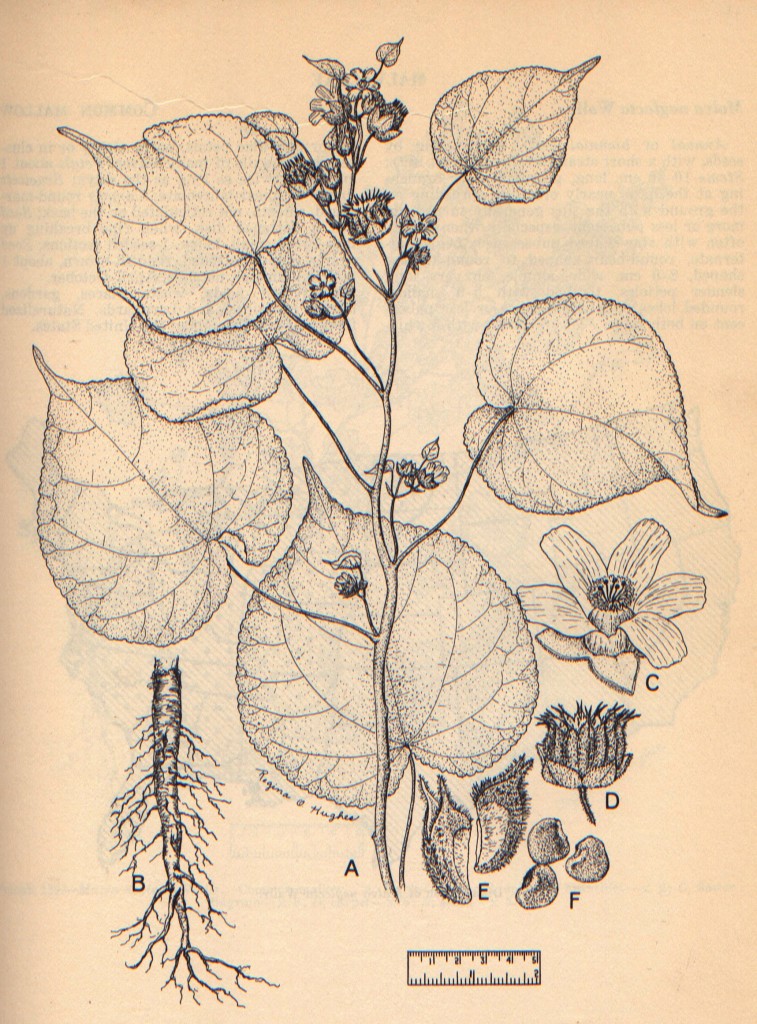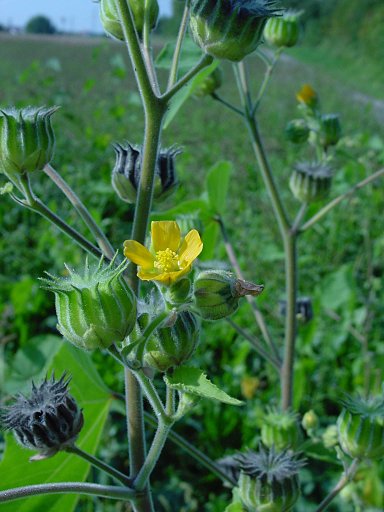
Abutilon theophrasti, photo by Precision Crop Protection
Velvet Leaf is a commercial failure but a successful foreign invader. A flop as a fiber plant and cursed for its infiltration of food crops, it was first cultivated in China some 3,000 years ago. From there Abutilon theophrasti made its way nearly everywhere on earth. First the Mediterranean area, then Europe. It was introduced into North America before 1750 to make rope but never became popular for that. Instead it became an agricultural pest. That is has edible parts went by the wayside.
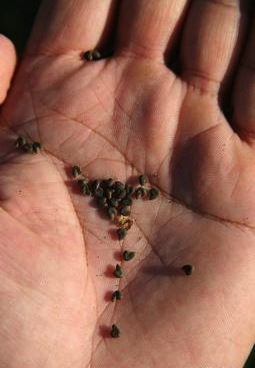
Velvet Leaf Seeds, photo by Robert Videki
The unripe seeds are edible raw. Where the plant is native its seeds are a common outdoor snack of children. Ripe seeds, however, must be leached until not bitter. Then dried they are ground into flour. Usually the flour was used to make noodles. The seeds contain between 15 and 30% oil. Even though the plant has edible seeds — young seeds taste similar to sunflower seeds — it ends up on the bottom of surveyed edible species in China because there are better alternatives. Worldwide there are some 160 species in the genus with several being used for food in various ways among them Abutilon guineense and Abutilon megapotamicum. With A. guineense the flowers are consumed raw and leaves are eaten like Marsh Mallow. The seeds are also cooked and eaten but it they are more valued for their expressed oil. A. megapotamincum’s flowers are eaten like vegetables.
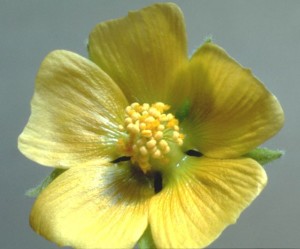
Velvet Leaf Blossom, photo by King County
Usually Abutilon theophrasti is found near farming activities: gardens, crop fields, nurseries, orchards, groves and the like. It’s significant problem where corn, cotton or soybeans are grown sometimes displacing 35% or more of the crop causing losses in the hundreds of millions of dollars. As a fiber source in Asia it has been used for rope, bags, coarse cloth, fishing nets, paper stock even caulking boats.
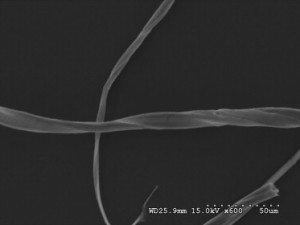
Single Velvet Leaf Fibers, photo from Bioresource Technology
In today’s world of artificial fibers it is difficult to imagine how important the plant fiber was to society hundreds of years ago, not only for clothes but for every day life. Consider sailing: All shipping relied on rope. Most ships carried several 120-fathoms (720-foot) long ropes. The USS Constitution had seven such ropes. A large ship could have 3.5 miles of rope that had to be replaced every two to four years. Companies that made cordage were called “ropewalks.” The first one opened in Boston in 1641. By 1794 there were 14 ropewalks in that city alone. In 1810 there were 183 ropewalks in the young United States. During those early years fiber for rope making was imported from Europe or Russia, which concerned the U.S. Navy then just as critical materials from hostile sources are a concern today. In 1825 it was reported that:
In answer to the resolutions of the Senate of the United States, of the 17th of May last, that the President of the United States be requisitioned to cause a report from the Secretary of the Navy to be laid before the Senate at the commencement of the next session of Congress showing the reasons, if any, why canvas, cable and cordage, made of hemp, the growth of the United States, may not be used in the equipment of national vessels with equal advantage as if of foreign fabrics or materials.
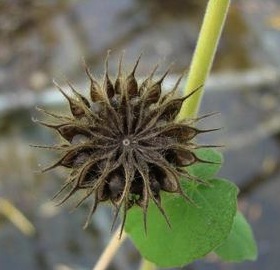
Ripe Seed Pod, photo by Invasive.org.
In 1751 the Gardener’s Dictionary by Phillip Miller describes Abutilon as: “The first sort here mentioned is an annual plant, which is hardy enough to come up in the common ground, and will perfect its seeds without any trouble; but does not bear to be transplanted, unless when the plants are very young, so that the seeds should be sown where the plants are designed to remain; and if the seeds are permitted to fall, they will come up the following spring without any care. This is very common in Virginia and most of the other parts of America; where it is called by some of the inhabitants Mash-mallow, because the leaves are soft and woolly. There is not great beauty in this sort.” There’s actually a little more to that story. Miller (1691-1771) chief gardener at the Chelsea Physic Garden from 1721 until his death, didn’t like Carl Linnaeus’ binomial system even after meeting Linnaeus in 1736. Thus Miller didn’t create the Albutilon genus until 1768, three years before he died getting it into his seventh edition of his Gardener’s Dictionary. Theophrasti was added some 21 years later by Friedrich Casimir Medicus (1736-1808) director of the garden at Mannheim during the late 18th century. He, too, had a bit of a naming snit with Linnaeus.
Over the next 120 years much effort was made to create a home-grown fiber industry in the United States. Meanwhile Velvet Leaf was becoming an agricultural pest in food crops. An Illinois committee report in 1871 alluded to the growing problem. The committee said it had: ” … examined the fiber as exhibited on the stalk, and as dressed for use, in its various colors and qualities and as made into thread, cordage and ropes, and consider that its promise of permanent utility is indeed quite flattering. We have no doubt but that this detestable weed will be found far more valuable in (the) future, in our ropewalks, than it has heretofore proven in our corn fields.” The committee added it hoped: … Illinois and the great Northwest may yet find, in this hetherto most common and noxious weed, a plant of great profit to their people…” In the end Velvet Leaf never became the great promised fiber plant in North America because of the lack of machinery to economically process it.
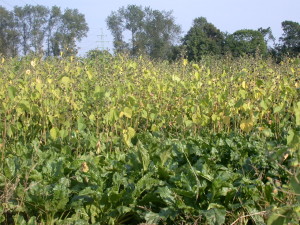
A stand of Velvet Leaf, photo by Precision Crop Protection
In the greater mallow family Abutilon (ah-BLEW-tee-on) is from an Arabic name for a similar plant, which is not much help in identification. The word was created around 900 B.C., by Avicenna-or Ibn-Sina for plants resembling a mallow or mulberry. The species name isn’t much help either, Theophrasti. That means “of Theophrastus.” Unfortunately Theophrastus is not a place but a Greek, born around 370 BC who lived to be 82 or so and is considered the ‘father of botany.’ He wrote several books on the history of plants and six books on “The Causes of Plants.” A student of Aristotle, he might have mention the plant or something like it in one of his books. Guineense means ‘of Guinea’ and megapotamicum is Dead Latin for Rio Grande which means big river. A. megapotamicum grows near the Rio Grande. Other common names for Velvet Leaf include: Buttonweed, Indian Mallow, Butterprint, China Jute, Abutilon Hemp, Manchurian Jute, American Jute, Tientsin Jute, Piemaker, and in Chinese Ching-ma. It’s debatable whether the plant is native to India or China.
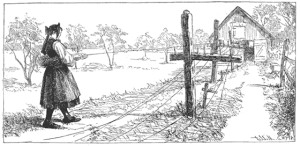
A reversed pen drawing entitled “A Rope-walk” by Frank Millet shows a Vierlande maid crafting rope in the traditional way.
Besides North America Velvet Leaf is native or naturalized in China, India, Iran, Israel, Japan, Kazakhstan, South Korea, Pakistan, Turkey, Bulgaria, Croatia, Denmark, the Former Yugoslavia, France, Germany, Greece, Hungary, Italy, Netherlands, Poland, Portugal, Romania, the Russian Federation, Slovenia, Spain, Sweden, Switzerland, Ukraine, United Kingdom. Eritrea, Ethiopia, Morocco, Canada and the United States.
Green Deane’s “Itemized” plant profile: Velvet Leaf
IDENTIFICATION: Abutilon theophrasti is a subshrub to about six feet, or two meters, often just a few feet. The stem and twigs are covered with fine hair. Leaves are heart-shaped and alternate. They are very fuzzy and have just a hint of teeth around the edge. One flower per leaf axils is produced, yellow, five petals, slightly notched. Self-pollinating each plant can produce up to 17,000 seeds and the seeds can remain viable for 60 years. One researcher reported 43% seed germination after 39 years of burial. Seed pods are usually densely covered with soft bristles. Nearly black at maturity. The seed capsule has a cup-like ring formed by 12 to 15 woody segments that remain intact at maturity. Each segment releases one to three seeds through a vertical slit on the outer face of the capsule. Seeds range from kidney shaped to almost triangular, have a notch, are flattened, and about one eighth of an inch long, purplish brown, brown, or black, smooth or have tiny star-shaped hairs
TIME OF YEAR: Leafs out in spring, flowers in the summer, seeds in fall, hardy to zone 4 and is found in North America between 32 and 45 degrees north.
ENVIRONMENT: Likes well-drained neutral soil high in nitrogen (read agricultural land.) Moist. Full sun, will tolerate some shade. Seeds, adult plants, and decaying plant contain or produce allelopathic chemicals limiting the growth of surrounding crop plants.
METHOD OF PREPARATION: Unripe seeds raw, ripe seeds leached of bitterness, dried, then ground into flour. In other species flowers and or young leaves are edible. Oh… one last thing. The leaves can be used as toilet paper.
To see a short video on the plant as a source of fiber go here.

